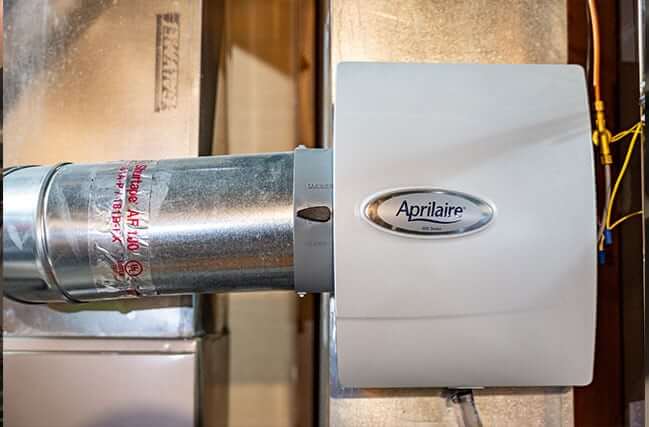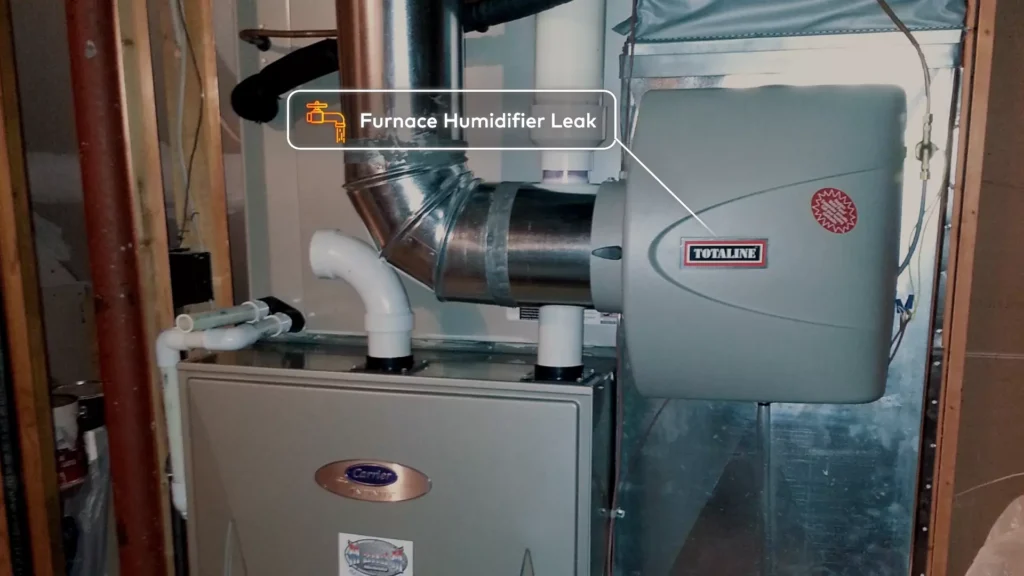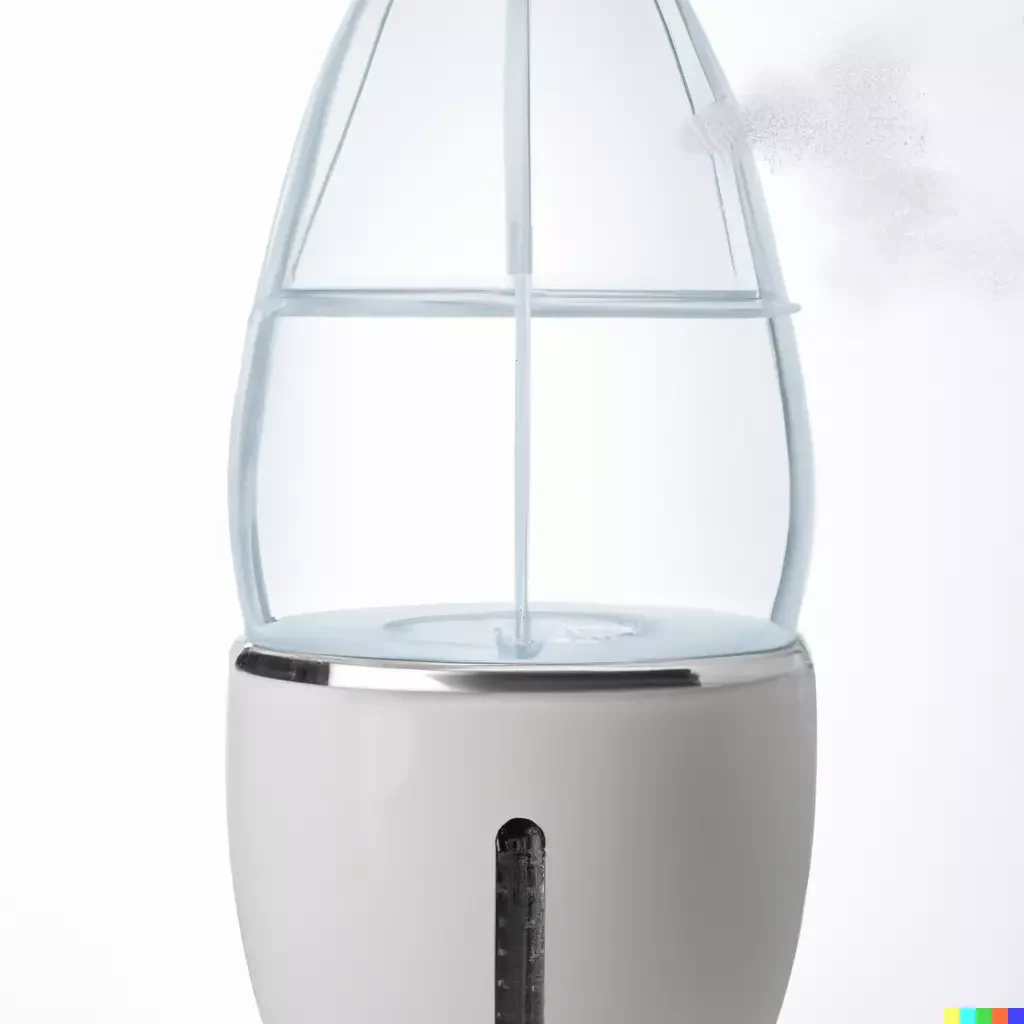A furnace with a humidifier integrates temperature control with moisture management. This combination enhances indoor air quality and comfort.
Maintaining an ideal indoor climate involves more than just adjusting the temperature; it also requires regulating humidity levels. A furnace equipped with a humidifier serves this dual function effectively, ensuring your home remains cozy and the air you breathe is healthier, especially during dry winter months.
This integration can help alleviate respiratory discomfort, prevent dry skin, and protect wooden furniture from cracking. By ensuring proper moisture levels in the air, a furnace with a humidifier also allows you to feel warmer at lower temperatures, which can lead to energy savings. As homeowners prioritize comfort and health, investing in a furnace with a humidifier could be a wise decision for a more pleasant and efficient living environment.

Credit: www.airprofessionalsnj.com
Benefits Of Integrating A Humidifier With Your Furnace
The integration of a humidifier with your furnace can revolutionize the way you experience comfort in your home. Imagine living in a space that not only feels warm but also maintains a balanced level of moisture in the air. This fusion offers a multitude of advantages for both your health and your living environment.
Improved Air Quality And Comfort
Combining a humidifier with your heating system does wonders for indoor air quality. Here’s what you can look forward to:
- Balanced Humidity: Say goodbye to dry air that irritates your senses. Enjoy consistent moisture levels all day.
- Preserved Wood: Furniture and floors made of wood stay in top shape. No more warping or cracking.
- Energy Savings: Moist air feels warmer. Lower your thermostat and save money on energy bills.
Health Advantages Of Optimal Humidity Levels
Your health gets a boost when you maintain optimal humidity levels at home:
- Fewer Illnesses: Viruses and bacteria struggle to survive. You and your family get sick less often.
- Skin Hydration: Dry, itchy skin becomes a thing of the past. Revel in soft, supple skin no matter the season.
- Respiratory Relief: Breathe easier as well-conditioned air soothes your airways. Sinus issues diminish significantly.
:max_bytes(150000):strip_icc()/anatomy-of-the-home-furnace-humidifier-1824773color-d41575bdba834fd59ac29178949a1e2a.png)
Credit: www.thespruce.com
How A Furnace Humidifier Works
A furnace humidifier makes homes more comfortable in winter. It attaches to your furnace and adds moisture to the air. This device ensures your indoor air isn’t too dry. Let’s look at how it works, including its evaporation process and integration with your home’s heating system.
The Role Of Evaporation In Humidity Control
A furnace humidifier uses evaporation. Water turns into vapor and mixes with warm air. The air blows through ducts and comes out of vents. Here’s how:
- Water reservoir: A small tank holds water.
- Humidifier pad: Air passes over a wet pad or filter.
- Evaporation: Water from the pad evaporates into the air.
- Distribution: Moist air flows through your house.
Integration With The Heating System
Your furnace heated air dries out. The humidifier adds moisture back. It connects to your furnace. It uses the furnace’s air to spread humidity. Here’s a simplified process:
- Trigger: You set a humidity level on a control panel.
- Activation: When heat runs, the humidifier turns on.
- Measurement: A sensor checks the humidity level.
- Control: It turns off when the air reaches your set level.
This system works seamlessly with your heating. It maintains comfortable air in your home.
Types Of Furnace Humidifiers
When winter comes, the air gets dry. A furnace with a humidifier is essential. It makes your home comfy. It stops the static and helps with your skin. Let’s look at the different types that you can choose from.
Bypass Humidifiers
A bypass humidifier works with your furnace. It uses the furnace’s blower. It does not need its own fan. When your furnace runs, it sends heat through a water panel. This adds moisture to your air. It is quiet and saves space. It is a good fit for small to medium homes.
Key points about Bypass Humidifiers:
- No extra fan needed
- Eco-friendly with low power use
- Perfect for small homes
Fan-powered Humidifiers
A fan-powered humidifier is like the bypass. But it has its own fan. This means more moisture faster. It works even when the furnace is off. This suits medium to large homes. They’re easy to install. They need more power but give more comfort.
Advantages of Fan-powered Humidifiers:
- Own fan for more moisture
- Works without the furnace
- Good for bigger spaces
Steam Humidifiers
The steam humidifier is the big one. It makes steam to moisten the air. It works fast. It can handle big homes. Also, it works independently from the furnace. It’s the best at control. It uses more electricity.
Why Steam Humidifiers stand out:
- Fast and powerful moisture
- Works without furnace heat
- Top choice for large homes

Credit: www.aprilaire.com
Installation And Maintenance
Integrating a furnace with a humidifier promises a cozy, balanced home environment. Ensuring proper installation and regular maintenance is crucial for optimal performance. Let’s explore how experts handle installations and the simple steps toward maintaining your system.
Steps for Professional InstallationSteps For Professional Installation
Qualified technicians follow strict procedures when installing a furnace with a humidifier. Below is an overview of these steps:
- Selecting the right model: Matching your home’s size with a suitable furnace and humidifier.
- Safety checks: Verifying the location for any hazards or restrictions.
- Installation: Mounting the humidifier unit to the furnace, ensuring seamless integration.
- Water supply: Connecting to a water source with leak-proof plumbing.
- Electrical connections: Wiring the system to power controls and sensors.
- Testing: Running the system to ensure everything functions as expected.
- User education: Demonstrating proper use and maintenance to homeowners.
Routine Cleaning And Care
Regular maintenance keeps your system running smoothly. Follow these points to maintain your furnace with built-in humidifier:
- Filter replacement: Change or clean filters every 30-60 days.
- Cleaning the humidifier: Remove mineral deposits and bacteria.
- Inspecting: Check for wear or damage periodically.
- Professional servicing: Schedule annual inspections for expert care.
Cost Considerations And Energy Efficiency
Integrating a humidifier with your furnace might seem like a costly venture. Yet, evaluating the benefits in energy efficiency and comfort could reveal substantial savings. It is crucial to understand both the immediate expenses and the long-term cost implications. These considerations help to assess the true value of such an investment.
Upfront Investment vs. Long-Term SavingsUpfront Investment Vs. Long-term Savings
The initial investment includes the purchase and installation costs of a furnace with a humidifier. The price varies depending on brand, capacity, and features. Don’t let these numbers discourage you; consider the savings on heating expenses over time due to improved energy efficiency.
- Enhanced air quality leads to reduced thermostat settings.
- Proper humidity levels make you feel warmer at lower temperatures.
- A humidified environment minimizes heat loss and furnace workload.
Impact On Utility Bills And Carbon Footprint
Monthly energy bills often reflect the true cost of an appliance. A furnace with a built-in humidifier can create a comfortable climate efficiently. This decreased energy consumption directly affects your utility bill. Additionally, efficient energy use results in a smaller carbon footprint.
| Without Humidifier | With Humidifier |
|---|---|
| Higher thermostat settings | Lower thermostat settings |
| Increased energy use | Reduced energy use |
| Larger carbon footprint | Smaller carbon footprint |
A furnace with humidifier requires less energy to maintain comfort. This sustainability aspect is a major advantage. A lower carbon footprint means a healthier planet for all.
Troubleshooting Common Issues
Furnaces with built-in humidifiers ensure a comfortable home environment during the dry winter months. However, like any complex system, they can experience issues. Homeowners can resolve many common problems with the right guidance. This section covers how to handle typical problems effortlessly.
Identifying And Resolving Leaks
Finding water around your furnace can be worrying. First, inspect for clear signs of leakage. Check hoses and connections for tightness. Look for cracks in the water reservoir too. If you spot a leak:
- Turn off the unit immediately to prevent damage.
- Examine the humidifier’s components for obvious signs of wear or damage.
- Replace damaged parts like hoses or valves.
If the problem persists, contact a professional to ensure proper sealing and operation.
Dealing With Mineral Buildup
Mineral deposits from hard water can clog your humidifier over time. These blockages can lead to poor performance. To handle this:
- Disconnect power to the humidifier and shut off the water supply.
- Clean the humidifier components with a vinegar solution to dissolve minerals.
- Rinse thoroughly with clean water after soaking.
- Replace any filters as recommended by the manufacturer.
Regular maintenance will keep mineral buildup at bay and extend the life of your system.
Frequently Asked Questions Of Furnace With Humidifier
Is It Good To Have A Humidifier On Your Furnace?
Having a humidifier attached to your furnace can improve indoor comfort by adding necessary moisture to dry air during heating seasons. It can also reduce potential irritations caused by dryness.
How Much Does It Cost To Add A Humidifier To Your Furnace?
The cost to install a furnace humidifier typically ranges from $400 to $700. Prices vary based on the humidifier type and installation complexity.
Can You Add A Humidifier To An Existing Furnace?
Yes, you can add a compatible humidifier to an existing furnace to enhance home comfort and air quality. Consult with a HVAC professional for proper installation.
Is It Hard To Install Furnace Humidifier?
Installing a furnace humidifier can be challenging and requires electrical and HVAC knowledge. Professional installation is recommended to ensure proper setup and operation.
Conclusion
Ensuring home comfort year-round is essential, and a furnace with a humidifier does just that. It’s an investment in household health and energy efficiency. Remember, proper maintenance guarantees top performance. Embrace the benefits of balanced humidity; your family, and your wallet, will thank you.
Ready to enhance your indoor air quality? Consider the upgrade now.





